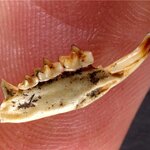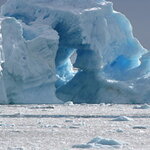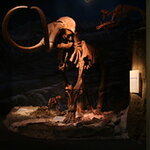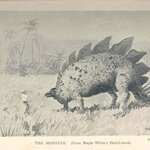Paleontology

Morphometric and phylogenetic analyses of the fossilised remains of the jaws and teeth of a shrew discovered in a deposit in Gran Dolina de Atapuerca, in Burgos, a city of northern Spain at the edge of the central plateau, have shown this to be a new species (Dolinasorex glyphodon) that has not previously been described. The extinct animal had red teeth, was large in size compared with mammals of the same family, and was more closely related to Asian than European shrews.
Researchers from the University of Zaragoza (UNIZAR) have discovered fossils in the TD4, TD5 and TD6 levels of the Gran…

The discovery of a gruesome feeding frenzy that played out 73 million years ago in northwestern Alberta may also lead to the discovery of new dinosaur species in northwestern Alberta.
University of Alberta student Tetsuto Miyashita and Frederico Fanti, a paleontology graduate student from Italy, made the discovery near Grande Prairie, 450 kilometres northwest of Edmonton.
Miyashita and Fanti came across a nesting site and found the remains of baby, plant-eating dinosaurs and the teeth of a predator. The researchers matched the teeth to a Troodon, a raptor-like dinosaur about two metres…

Radiolarians are exquisitely beautiful amoeboid protozoa that have been living as zooplankton in the world’s oceans for about 600 million years.
These tiny, siliceous, single-celled organisms with their intricate mineral skeletons make-up the world's smallest clocks. Because they occur in continuous and well-dated sequences of rock over large portions of the ocean's bottom, these minuscule microfossils act like a yardstick, helping geologists accurately date rock from around the globe from the Cabrian onwards.
So, take off that Timex and strap-on your protozoa. Not as…
What we find at crime scenes and fossil sites is just as interesting as what is missing. We see this play out in some of the freshwater sites of British Columbia.
The Okanagan Highlands act as the epicentre to an arc of 50-million lakebed sites that extend from Smithers in the north to the fossil sites of Republic, Chuckanut in Washington state. The grouping includes the fossil sites of Driftwood Canyon, Quilchena, Allenby, Tranquille, McAbee, Princeton and Republic. These fossil sites range in time from Early to Middle Eocene, and the fossil they contain give us a…

Evidence from the past provides a crytal ball for the future. A sediment core from 400m below the seabed of the Arctic Ocean showed that Fifty-five million years ago, deep in the Eocene, the North Pole was ice-free and enjoying tropical temperatures. It also told us that the temperature of the ocean was 20C, instead of the coolish –1.5C we see today… a truth that is hard to imagine with all the hype around global warming.
The bottom end of that core helped explain the fossils found at Eocene sites around British Columbia, species commonly seen in more tropical environments today.
The…

How about a dating service where your male partners are chosen for their fitness from the Siberian permafrost? Creating long extinct life through harvested genetic remains is closer than you think. After successful experiments at the Institute for Reproductive Studies in Scottsdale, Arizona, with frozen mice sperm, scientists are now experimenting with sperm from mammoths preserved in Siberian ice.
We may one day have wooly mammoths (Mammuthus primigenius), extinct since the Pleistocene, roaming around zoos and colder climes. At least…

For those looking for a great family trip where you can enjoy the great outdoors and collect some fabulous fossils along the way, you need look no further than McAbee, a site near Cache Creek, just four hours north of Vancouver on the historic Gold Rush Trail. McAbee, named for the nearby village of McAbee on the Thompson River, is one of the richest and most accessible Eocene deposits in North America. While the site is now an arid hillside topped with finger-like hoodoos, some 51 million years ago it was a flourishing lake. As fish and other inhabitants died, their remains settled to…

A limestone countertop, a practiced eye and Google Earth all played roles in the discovery of a trove of fossils that may shed light on the origins of African wildlife.
The story concerns University of Michigan paleontologists Philip Gingerich, Gregg Gunnell and Bill Sanders and is the subject of a segment on the award-winning television series "Wild Chronicles," currently airing on public television stations (Episode 412---Looking Back; check listings for local air dates). "Wild Chronicles" is produced by National Geographic Television and presented by WLIW21 in association with WNET.ORG.…

"The Lost World", published in 1912, is not Sir Arthur Conan Doyle's most famous work but his account of an isolated community of dinosaurs that survived the catastrophic extinction event 65 million years ago has lasted into modern times in a way Sherlock Holmes has not - at least until the new Robert Downey movie comes out with him in the starring role.
For a century, various Hollywood versions have tried to recreate the lost world of dinosaurs but maybe it wasn't as lost as we thought. New evidence suggests that dinosaur bones from the Ojo Alamo Sandstone in the San Juan Basin date…
A great temple to the god Amon was built at Karnak in Upper Egypt around c. 1785. It is from Amon that we get his cephalopod namesake, the ammonites and also the name origin for the compound ammonia or NH3.
Ammonites were a group of hugely successful aquatic molluscs that looked like the still extant Nautilus, a coiled shellfish that lives off the southern coast of Asia. While the Nautilus lived on, ammonites graced our waters from around 400 million years ago until the end of the Cretaceous, 65 million years.
Varying in size from millimeters to meters across, ammonites are prized…